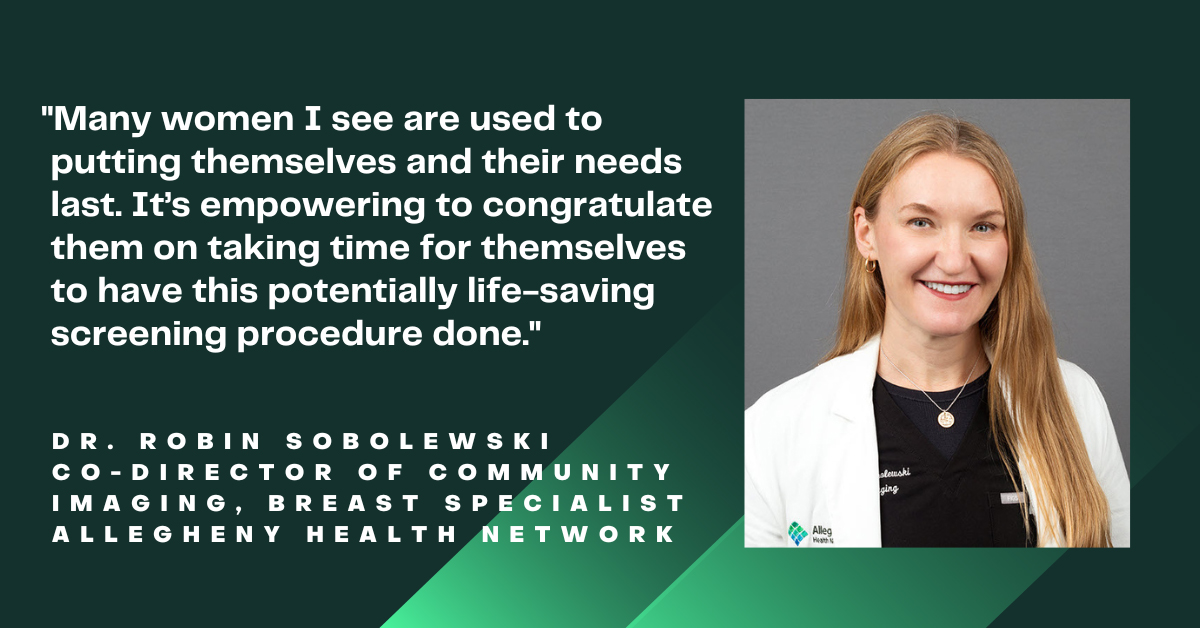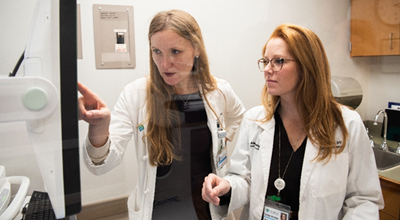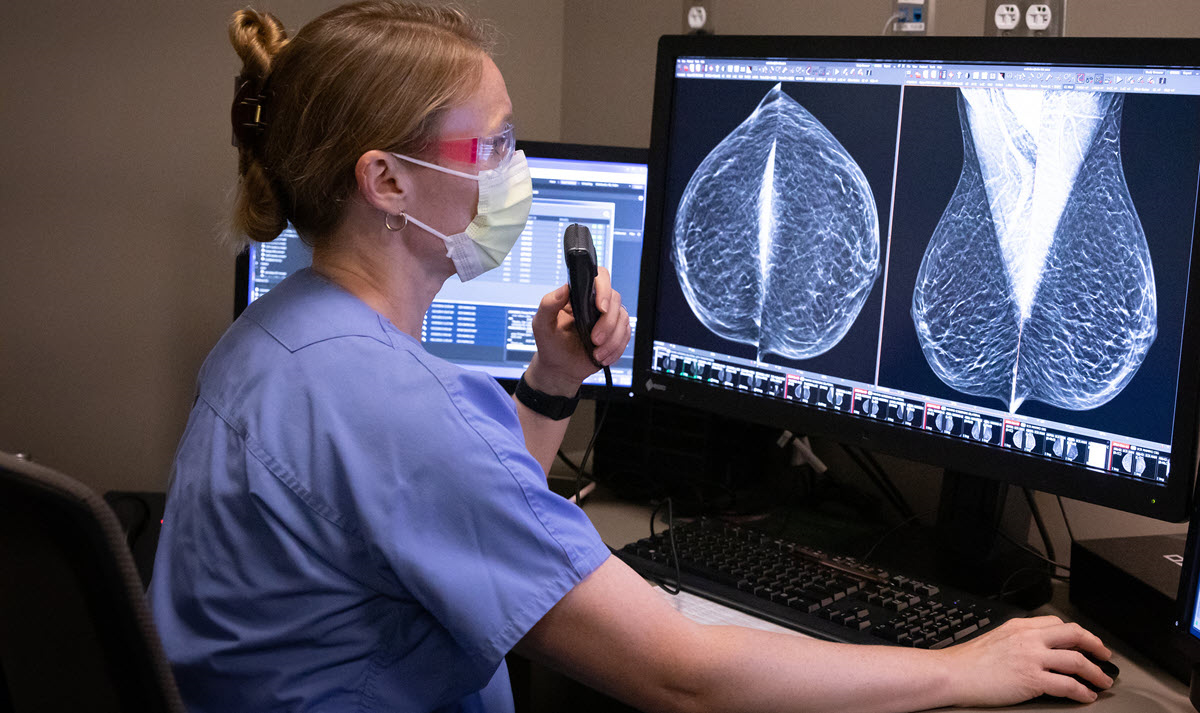Editor's Update: This article was first published September 22, 2020. It was most recently reviewed and updated October 23, 2023.
In our Ask a Doc series, we sit down with physicians and other clinical experts, including those at Allegheny Health Network (AHN), for a chat on an important health topic. In this article, we learn about breast cancer screening from Robin Sobolewski, MD, Co-Director of Community Imaging, Breast Specialist, AHN.

Dr. Robin Sobolewski wants women to adjust how they think about their annual mammogram screening. Instead of considering it a chore, or something that inspires anxiety, she wants them to recognize it as an act of self-care.
She points out that many women juggle careers and a higher percentage of caregiving responsibilities, allowing their own well-being to land on the backburner. “I’m inspired by the chance to empower women with the knowledge to understand their bodies, how to take care of them, and the desire to practice self-care in the form of an annual screening,” she explains.
To raise awareness about the importance of breast cancer screenings, she and I discussed general recommendations and risks, what to expect from the procedure, overcoming anxiety and other obstacles, and her concept of screening as self-care.
Emily Adamek: Who needs to be screened for breast cancer and when?
Dr. Robin Sobolewski: For women across the board, we start screening mammography at age 40. I'll add that this is aligned with many major health organizations, including the American Cancer Society, the American College of Radiology, the Society of Breast Imaging, and the American Society of Breast Disease; all agree that starting annual mammography at age 40 saves the most lives.
That said, we recommend that any doctor who sees a patient age 30 or over — this could be primary care doctors (PCPs), obstetrician-gynecologists (OBGYN), or internists — should ask certain questions to determine whether a woman is at an increased risk of developing breast cancer, and therefore should start screening earlier. They might ask whether the patient has a first-degree relative (parent, sibling, or child) who had an early age breast cancer diagnosis. If the answer is yes, they might require a screening prior to age 40. They might also ask about a personal history of biopsies, genetic history or other risk factors. In 2022, the American College of Radiology went a step further, updating their recommendations to suggest that women talk to their doctor about breast cancer risk beginning at age 25 and to also ask about the potential benefit of additional screening.

Dr. Robin Sobolewski, left, with Dr. Sarah Thomas, a radiologist specializing in breast imaging.
Emily Adamek: Is it common to have breast cancer without experiencing symptoms?
Dr. Robin Sobolewski: That’s very common, and why we do the imaging — to find cancer that isn’t detectable by the patient. That’s why it’s important to get the screening even if there are no symptoms.
Some patients do come in with a new lump or bump. Many of those will be benign, but some lead to finding cancer. Breast pain is another common reason women come in, but quite a few studies have concluded that there is little or no correlation between breast pain and cancer, if pain is the only symptom.
Emily Adamek: Is there ever a scenario where a breast self-exam is enough, replacing the need for a mammogram?
Dr. Robin Sobolewski: Absolutely not — but self-exams are important in addition to annual screenings. If lumps become apparent between mammograms, those should always be evaluated by a physician. If the physician thinks it’s necessary, then an imaging study would be scheduled without waiting for the next screening.
Emily Adamek: Do men need to be aware of breast cancer screening?
Dr. Robin Sobolewski: Men can get breast cancer — it’s rare, but it does happen. However, we don’t have any screening recommendations or standard screening practices for the general population of men unless they have a genetic history. We recommend that if they feel any lumps or bumps in either breast or armpit, they should see a doctor. If their doctor thinks they need imaging, they’d be referred to us.
Emily Adamek: What imaging options are available for breast cancer screening?
Dr. Robin Sobolewski: In some patient populations, we do additional screening with an ultrasound or MRI, but across the board, mammography is the gold standard. More specifically, 3D mammograms, when available, are the standard of care across the country. 3D mammography has many benefits, including that we can pick up additional cancer that may not have been noticeable before this technology existed. In some ways, it’s similar to a CAT scan in that it’s taking images through the body and breast tissue.
Imagine a loaf of raisin bread. If you just looked at the surface, you wouldn’t see all the raisins, but if you cut into it, you see much more clearly how many raisins are inside. By giving us that clearer, more comprehensive view from the start, 3D screening can significantly reduce the number of women who have to be called to come back for additional imaging.
In Pennsylvania, state law requires PA-based insurance companies to cover mammogram screening, including 3D mammography. We offer 3D mammography to everybody, and find that the majority are covered by insurance.
Emily Adamek: Are there any risks associated with the screening?
Dr. Robin Sobolewski: No. We produce high-quality breast images with an extremely low dose of radiation. It’s about as much exposure as you get from your natural surroundings over a few weeks.

There’s no substitute for catching cancer early while it can often be treated less invasively and more successfully.
Emily Adamek: Why do you think some women are hesitant or avoid getting screened? How would you encourage them?
Dr. Robin Sobolewski: I think part of the hesitance comes from the exam itself. It’s not comfortable. But having had them myself, I know it’s extremely quick. Technology has improved, too, so it’s much less uncomfortable than it was even a few years ago. We’re able to take all the images in one quick click.
Plus, that moment of discomfort may save you the greater discomfort from treatment of advanced cancers. The earlier we catch cancer, the easier it is to treat, and the less invasive treatment needs to be. If we don’t actively look for it and it just shows up eventually, it will likely be at a stage where it’s larger and harder to treat.
Another issue is obviously the anxiety of potentially finding out you have cancer. I understand that fear, but you have to remind yourself that, again, catching cancer early can be life-saving and usually means an easier path of treatment.
In terms of pushing past the anxiety, I ask women to prioritize their health. Just as it’s important to have routine dentist visits to have your teeth evaluated for cavities, it’s important to have your annual mammogram screening. It’s part of self-care.
Emily Adamek: I think clarity can be a good alleviator of anxiety. Using your example, most of us have a thorough understanding of what happens at a dentist visit. For someone who hasn’t had a mammogram, can you describe what to expect when you come in for a screening?
Dr. Robin Sobolewski: Sure. First, they’ll be asked to change into a gown and be brought into a mammogram room. There, the technologist will perform the standard imaging, taking into account the patient’s physical status. For example, some patients may need a wheelchair or walker, or the screening can potentially be performed from a chair. Also, breast sizes differ, so the technologist will maximize their technique to take the best possible image of any size or shape of breast.
During the imaging, you’ll feel pressure on the breast, but within seconds it is released from compression and the image is done. It’s important for patients to stay as still as possible for those few seconds, and the technologist will coach them through that. Once the images are taken in two views on both sides, the exam is complete.
Emily Adamek: If a patient is called back in after their initial mammogram, should they immediately start to worry?
Dr. Robin Sobolewski: Definitely not. The breast is not a square, so when we put it between our paddles from year to year, it might be in a slightly different position. The pattern of breast tissue itself is almost like looking at clouds in the sky. Every technologist does their best to maximize the exact positioning, but we’re trying to take a flat picture of a 3D object. That means a large portion of what we see that would lead to a call-back will end up being normal tissue. It’s better not to worry and just come in promptly for the additional imaging to make sure.
Emily Adamek: How does the process play out if someone does have cancer?
Dr. Robin Sobolewski: If we see something with the imaging that needs more workup, I would tell the patient that we need a biopsy or tissue sampling, which I or another radiologist would perform. After that, when results come back, the patient would be given the results and next steps by either an AHN nurse navigator or by her referring doctor who knows her and her health.
If it is cancer and she’s never had a surgeon, she’ll get a referral to a breast surgeon, meet with them, and come up with a plan of care. She might also meet with an oncologist to determine whether or not she needs chemotherapy to shrink the tumor. Essentially, a whole team of physicians would be brought in to help her.
At AHN, her nurse navigator, usually someone she met at the time of the biopsy, will follow and support her through the whole process. Among other things, the nurse navigator can even give referrals for wigs, massage, and other stress relieving therapies. The navigator quite literally helps the patient throughout the entire experience.
Emily Adamek: I can imagine how valuable that would be. Other than nurse navigators, are there other aspects of AHN’s approach to breast cancer, or women’s health in general, that you would highlight?
Dr. Robin Sobolewski: Our focus is compassionate care and patient education. We have multiple breast cancer centers scattered throughout our region to make it easier for patients to find a convenient place to have their imaging done. We also have extended hours, which are important because many women work full-time and have other schedule challenges. So, whether it’s Saturdays, week nights, early morning appointments, we try to accommodate as many people as we can.
Another thing we believe in is outreach. There are different community groups that we talk to throughout the year about the importance of screening. One group I’ve been involved with brings breast surgeons, lymphedema specialists, and oncologists to speak with the African American Women’s Speaker Bureau. These women take the information directly into their community, often through their churches, and encourage women to schedule a screening.
Emily Adamek: You mentioned breast cancer screening as self-care — could you talk more about that?
Dr. Robin Sobolewski: Many women I see are used to putting themselves and their needs last. I’ve had them tell me that they haven’t had their screening because they were busy taking care of others. It’s empowering to congratulate them on taking time for themselves to have this potentially life-saving screening procedure done. Screening is like the instruction you get on a plane to put your oxygen mask on first. You have to take care of yourself to be able to take care of others.